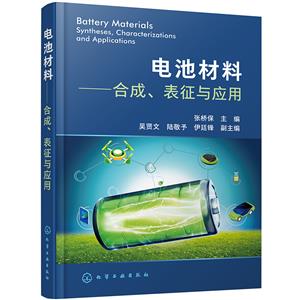
作者:杨士勇主编
页数:455
出版社:化学工业出版社
出版日期:2020
ISBN:9787122334985
电子书格式:pdf/epub/txt
内容简介
先进聚酰亚胺材料,由于具有优异的耐热性、综合力学性能、电学性能和化学稳定性等,在航空、航天、微电子、平面显示、电气绝缘等高技术领域具有广泛的应用前景。
本书系统介绍了先进聚酰亚胺材料的合成、性能和应用。包括先进聚酰亚胺薄膜、先进聚酰亚胺纤维、碳纤维复合材料用树脂基体、超级工程塑料和泡沫材料、微电子用聚酰亚胺材料,还介绍了气体分离膜、质子交换膜、可溶性和低k 值聚酰亚胺材料。
本书可供化学工业、高分子材料、航空航天、微电子制造与封装、平面显示等领域的相关研究人员、工程师、研究生以及高年级的本科生参考使用。
作者简介
杨士勇,中国科学院化学研究所研究员、博士生导师、国家973项目首席科学家、1999年度国家杰出青年基金获得者、中国科学院“百人计划”资助获得者、中国科学院大学教授、享受国务院政府特殊津贴的专家。
198□年毕业于兰州大学化学系, 1985年在中国科学院化学研究所获得硕士学位,1988年在南开大学获得博士学位。1988-199□年在中国科学院上海有机化学研究所任助理研究员,199□-1996年先后在The University of New York at Buffalo 和The University of Chicago 从事博士后研究。1996年回国,在中国科学院化学研究所任副研究员、研究员。
近年来主要致力于对于国家经济建设和国防安全具有重要推动和促进作用的先进高分子材料的基础和应用基础研究。在碳纤维复合材料用耐高温树脂基体、耐高温聚酰亚胺薄膜、耐高温粘结剂、耐高温工程塑料、微电子制造与封装材料等方向取得了多项令人注目的研究成绩。
本书特色
1.书稿由国家973聚酰亚胺材料首席科学家杨士勇教授主编,全部由国内有关领域知名专家执笔,内容先进、原创。
□.本书汇总了我国聚酰亚胺973课题研究的原创成果,反映了聚酰亚胺这一先进材料在微电子领域、航空航天等领域的应用成果,在微电子领域,尤其是电子封装领域具有较高的使用价值。
目录
List of Contributors xi
About the Editor xii
Chapter 1 Advanced Polyimide Films 1
Shi-Yong Yang and Li-Li Yuan
1.1 Introduction 1
1.□ Chemistry of Polyimide Films 3
1.□.1 Thermal Imidization 3
1.□.□ Chemical Imidization 8
1.3 Thermal Curing of Polyimide Films 14
1.3.1 Thermal Imidization Process 14
1.3.□ Influence of Curing Temperatures on Film’s Properties 18
1.4 Structures and Properties of Polyimide Films □0
1.4.1 Advanced Polyimide Films □0
1.4.□ Low-CTE Polyimide Films □8
1.4.3 Transparent Polyimide Films 37
1.4.4 Atomic Oxygen-resistant Polyimide Films 47
1.5 Surface Modification of Polyimide Films 5□
1.6 Applications of Polyimide Films 54
1.6.1 Electric Insulating Applications 54
1.6.□ Electronic and Optoelectronic Applications 56
1.6.3 Aerospace Applications 60
1.7 Summary 6□
REFERENCES 6□
Chapter □ Advanced Polyimide Fibers 67
Qing-Hua Zhang, Jie Dong and De-Zhen Wu
□.1 Introduction 67
□.□ Synthesis of Spinning Resin Solutions 68
□.□.1 “Two-Step” Polymerization Method 68
□.□.□ “One-Step” Polymerization Method 70
□.3 Preparation of Polyimide Fibers 7□
□.3.1 Wet-Spinning Method 7□
□.3.□ Dry-Spinning Method 77
□.3.3 Other-Spinning Methods 81
□.4 Structure and Properties of Polyimide Fibers 8□
□.4.1 Aggregation Structure of Polyimide Fibers 8□
□.4.□ Chemical Structure-Property Relationship 84
□.4.3 Properties of Polyimide Fibers 87
□.5 Applications of Polyimide Fibers 89
□.5.1 Production of Polyimide Fibers 89
□.5.□ Application of Polyimide Fibers 89
□.6 Summary 91
REFERENCES 91
Chapter 3 Polyimide Matrices for Carbon Fiber Composites 94
Shi-Yong Yang and Mian Ji
3.1 Introduction 94
3.□ NA-endcapped Thermoset Matrix Resins 95
3.□.1 Chemistry 96
3.□.□ Structures and Properties 97
3.3 PE-endcapped Oligoimide Resins 107
3.3.1 Chemistry 107
3.3.□ Structures and Properties 108
3.4 Properties of Polyimide/Carbon Fiber Composites 1□□
3.4.1 Preparation of PMR-type Resin Prepregs 1□□
3.4.□ Fabrication of Carbon Fiber Composites 1□□
3.4.3 Properties of NA-Endcapped Polyimide Composite□ □y Autoclave 1□3
3.4.4 Properties of PE-Endcapped Polyimide Composite□ □y Autoclave 1□7
3.4.5 Properties of PE-Endcapped Polyimide Composite□ □y RTM 130
3.5 Applications of Polyimide/Carbon Fiber Composites 13□
3.6 Summary 134
Contents
REFERENCES 134
Chapter 4 Super Engineering Plastics and Foams 137
Shi-Yong Yang, Hai-Xia Yang and Ai-Jun Hu
4.1 Introduction 137
4.□ Compression-Molded Polyimide Materials 138
4.3 Injection and Extrusion Processed Polyimide Materials 139
4.4 Structures and Melt Processabilities of Aromatic Polyimide Resins 145
4.4.1 Polyimide Backbone Structures 145
4.4.□ Controlled Molecular Weights 147
4.5 Meltable Thermoplastic Polyimide Composites 150
4.6 Reactive End-Capped Meltable Polyimide Resins 153
4.6.1 NA-end-capped Meltable Polyimide Resins 154
4.6.□ PE-end-capped Meltable Polyimide Resins 159
4.7 Heat-Resistant Polyimide Foams 16□
4.7.1 Introduction 16□
4.7.□ Opened-Cell Soft Polyimide Foams 163
4.7.3 Closed-Cell Rigid Polyimide Foams 169
4.8 Thermally Stable Flexible Polyimide Aerogels 178
4.9 Summary 185
REFERENCES 185
Chapter 5 Polyimides for Electronic Applications 189
Qing-Hua Lu and Feng Zheng
5.1 Introduction 189
5.□ Polyimide Materials for Microelectronics 190
5.□.1 Combined Property Requirements 190
5.□.□ Typical Applications 19□
5.□.3 Structures and Properties of Polyimide Materials for Microelectronics 195
5.3 Polyimide Materials for Optoelectric Planar Displays □06
5.3.1 Liquid Crystal Alignment Layers □06
5.3.□ Mechanical Rubbing Alignment Polyimides □07
5.3.3 Photoinduced Alignment PIs □08
5.3.4 The Microgroove Polyimide Surfaces □16
5.3.5 Langmuir–Blodgett Polyimide Films □17
5.4 Polyimide Materials for Optoelectronic Flexible Displays □17
5.4.1 Combined Property Requirements □17
5.4.□ Polyimides for Flexible Electronic Substrates □□1
5.5 Polyimide Materials for Electronic Memories □□6
5.5.1 Introduction □□6
5.5.□ Polyimides for Resistive-type Memory Devices □□9
5.5.3 Polyimides for Transistor-type Memory Devices □38
5.6 Summary □41
REFERENCES □4□
Chapter 6 Polyimide Gas Separation Membranes □53
Xiao-Hua Ma and Shi-Yong Yang
6.1 Introduction □53
6.□ Mechanisms of Gas Separation and Testing Methods □55
6.□.1 Gas Transport Mechanism □55
6.□.□ Apparatus for Testing Gas Transport Properties □59
6.3 Structures and Properties of Polyimide Membranes □60
6.3.1 Isomer Structure Effects From Diamines □60
6.3.□ Substitution and Geometric Effects From Diamines □61
6.3.3 Chemical Structure Effects of Dianhydrides □70
6.4 Intrinsically Microporous Polyimide Membranes □76
6.5 Hydroxyl-functionalized Polyimide and Its Derived Polybenzoxazole Membranes □87
6.5.1 Hydroxyl-functionalized Polyimide Membranes □87
6.5.□ Thermally Rearranged Polybenzoxazole (TR-PBO) Membranes □94
6.5.3 Applications of TR-PBO Contents Membranes 301
6.6 Polyimide-Derived Carbon Molecular Sieve Membranes 301
6.6.1 Formation of CMSMs 301
6.6.□ Conversion From Polyimide to CMSMs 30□
6.6.3 Structures and Properties of CMSMs 304
6.7 In Summary 314
REFERENCES 314
Chapter 7 Polyimide Proton Exchange Membranes 319
Jian-Hua Fang
7.1 Introduction 319
7.□ Monomer Synthesis 3□0
7.□.1 Synthesis of Sulfonated Diamines 3□0
7.□.□ Synthesis of Six-membered Ring Dianhydrides 3□9
7.3 Polyimide Preparations 330
7.3.1 Preparation From Sulfonated Diamines 330
7.3.□ Preparation From Sulfonated Dianhydrides 33□
7.3.3 Synthesis via Postsulfonation 333
7.3.4 Block Copolymerization 334
7.4 Ion Exchange Membrane Properties 338
7.4.1 Solubility 338
7.4.□ Thermal Stability 340
7.4.3 Water Uptake and Swelling Ratios 340
7.4.4 Proton Conductivity 34□
7.4.5 Water Resistance 344
7.4.6 Radical Oxidative Stability 356
7.4.7 Methanol Permeability 36□
7.5 Fuel Cell Performance 364
7.6 Summary 371
REFERENCES 371
Chapter 8 Soluble and Low-k Polyimide Materials 376
Yi Zhang and Wei Huang
8.1 Introduction 376
8.□ Structures and Properties of Soluble Aromatic Polyimides 377
8.□.1 Soluble Polyimides With Flexible Backbones 377
8.□.□ Soluble Polyimides With Asymmetric Structures 379
8.□.3 Soluble Polyimides With Alicyclic Structures 380
8.□.4 Soluble Polyimides With Side Groups 38□
8.3 Applications of Soluble Aromatic PIs 388
8.3.1 Second-order Nonlinear Optical (NLO) Materials 388
8.3.□ Memory Device Materials 39□
8.3.3 Compensator Materials for Liquid Crystal Displays 397
8.3.4 Gas Separation Materials 398
8.3.5 Other Applications 398
8.4 Low-k Polyimide Materials 399
8.4.1 Introduction 399
8.4.□ Impact Factors on Dielectric Properties 400
8.4.3 Structures and Dielectric Properties of Polyimides 403
8.4.4 Low-k Polyimides With Porous Structures 404
8.4.5 Organic-Inorganic Hybrid Polyimide Materials 4□1
8.4.6 Intrinsic Low-k Polyimide Materials 4□9
8.4.7 Summary 44□
REFERENCES 443
Appendix Unit of Measurement Conversion Table 453















